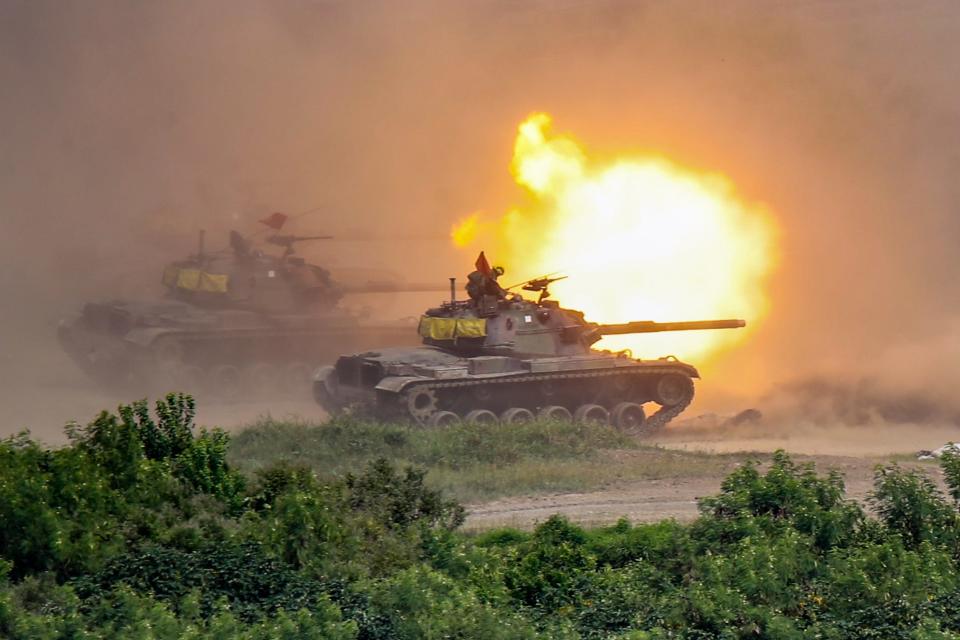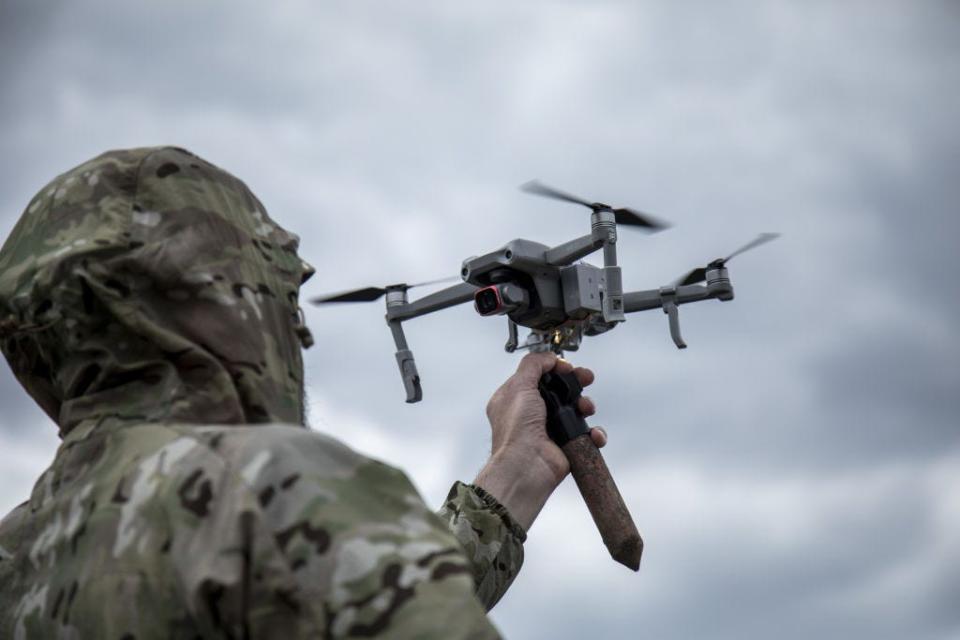Future wars are going to be catastrophic and robotic, and militaries have to 'come to grips' with that, former general says

The new novel "White Sun War" describes a horrific fight in the Western Pacific over Taiwan and a "new era" in warfare.
Robotics and AI play a major role in the fictional conflict. The former general who wrote the book says a real fight may look similar.
Mick Ryan, the author and a strategist, says militaries need to "come to grips" with what is coming.
A sudden burst of rapid-fire tactical messages shattered the early morning calm in Taiwan. "MULTIPLE SMALL AMPHIBIOUS VEHICLES LANDING AT BEACH. APPEAR TO BE AUTONOMOUS," one of the first messages read. More came in. "AERIAL SWARMS LAUNCHING," "BEACH OBSTACLES BEING DESTROYED," "SWARM ATTACKING AIRCRAFT," they read as it dawned on the island's shocked defenders that a terrible conflict long in the making had come at last. The first wave of China's assault was ashore, and the enemy was robotic.
The scene comes from a new novel, "White Sun War: The Campaign for Taiwan," written by a former military officer. It paints a bleak and unusual picture of a fictional great power war over Taiwan that erupts after decades of tensions between the US and China.
The author describes bloodshed mixed with warfighting technologies without precedent in combat. The war is an "unceasing maelstrom of death, suffering, and blood" but also a "new age in human-robot combat."
The military strategist who wrote the book says a real war might not be far off the mark.
When it comes to war, some things never really change, such as the uniquely human elements. Some things, however, are changing unbelievably fast, and future battlefields could look like nothing we have ever seen before.
Mick Ryan, a retired major general in the Australian military and author of the new techno-thriller "White Sun War," told Insider that this novel "should portray to everyone just how awful such a war might be."
"White Sun War" follows a handful of characters in the US, Chinese, and Taiwanese militaries through intense amphibious assaults, combat in the skies and beyond, and most importantly, hard fighting on the ground. It draws on past and ongoing high-intensity conflicts, from the truly catastrophic battles of World War II to the bloody war for Ukraine, to really capture the horrors of an invasion, as well as the terrifying chaos, threats, and numerous challenges of modern warfare.
In the book, the fighting is said to be like the brutal Battle of Tarawa, as opposed to say Afghanistan, yet Ryan said he feels his book "portrays the best case scenario," adding that "once these kinds of conflicts start, you start losing people. It is not a war game. It's not a sterile decision-making environment."
"There's every possibility that a whole range of unpredictable things could happen," he said. "That's the nature of war."

A pressing need to try to be 'invisible on the modern battlefield'
This new book explores the evolving realities in warfare and builds on the lessons of Ryan's earlier book "War Transformed." It discusses themes touched on by US Army Gen. Mark Milley, chairman of the Joint Chiefs of Staff, during a recent Foreign Affairs podcast interview. The top US general argued "speed, size, and being nearly invisible will be fundamental to survival on a future battlefield."
As the imaginary war over Taiwan unfolds, "White Sun War" describes different scenes in which a "profusion of military and civil sensor networks" result in rapid, "highly lethal kill chains" that force units to disaggregate and disperse, move constantly, and hide.
"There was no way to be invisible on the modern battlefield," one of the book's characters, an infantry officer, explains at one point in the story, "but you could reduce all your different signatures to make yourself a low-priority target for an adversary."
A principal of warfare has long been if you can be detected, you can be killed, but the ubiquitous presence of advanced signals intelligence capabilities and overhead reconnaissance coupled with long-range strike options have stretched the threat far beyond the immediate front lines. Ryan said elements of this change can already be seen in the war in Ukraine.
The former brigade commander said that "we've seen the integration of drones, sensors, artillery, and missile systems" close the "detection to destruction time to a very small amount of time" and make a "more transparent battlefield" where forces have to not only physically camouflage themselves but also disperse and mask their electronic signatures — the emissions from their communications devices, vehicles, and battlefield sensors.
The high-casualty conflict in Ukraine is not a one-for-one comparison with a potential war in the Western Pacific over Taiwan, but there are certain parallels, such as the pervasive surveillance operations that make it much harder to hide.
And unmanned assets play a major role in this. In the war in Ukraine, exploding drones have terrorized cities and their civilians as surveillance devices scan the battlefield and direct artillery.

Robotic systems will 'be persistent, and they will be ubiquitous'
War is fast moving in this new direction, Ryan said, predicting that remote-controlled and artificial intelligence-driven autonomous systems will become a greater presence in the military and its battlefield operations.
"At the end of the day, humans will still be making the key decisions about going to war, about the operational plane, but we need to find a different balance in this relationship with these autonomous systems that will be everywhere," Ryan said.
"They will be in every domain," he said. "They'll be persistent, and they will be ubiquitous. And we still have to really come to grips with that."
"White Sun War" presents a not too distant future in which AI impacts everything from wargaming to the operations of unmanned systems, the latter of which play an outsized role in a fight with decreased human input and combat scenarios in which "robots were slowly taking over the fighting."
The US military is already experimenting with AI-driven autonomous aircraft able to serve as attritable wingmen, unmanned surface vessels and undersea assets able to augment a naval force, and ground combat systems such as armed vehicles that can function as drone motherships and fire support.
Some systems also serve in other roles, such as logistics, data management, and casualty evacuation.
But, despite progress, this is still a new area of technological advancement, particularly artificial intelligence.
Ryan said that "military institutions are still very early in their appreciation of what this all really means because at some point we have to shift from a mindset of using these things to partnering with them," but they "haven't quite done that yet."
The incorporation of this kind of new technology into the armed forces, especially in the manned-unmanned space in which humans operate alongside autonomous robotic systems, will require substantial changes to training, leadership models, and doctrine. And it'd be better do that sooner rather than later, as you don't want to wait "with machines that can kill you," Ryan said.
"That is especially the case when the ratio of humans to autonomous systems in militaries is going to flip," Ryan told Insider. "At the moment, there's probably a hundred humans for every autonomous system in larger institutions. That ratio will change, and we need to think through all the cultural and organizational and tactical and strategic implications of that."
He said that if down the road there is a major war in the Western Pacific, "robots are going to be a part of it. There's just no getting away from that."
Ryan's observations match those of Milley in a Eurasia Group Foundation podcast interview, during which he said that within the next 15 years, maybe sooner, "you're going to see significant portions of armies and navies and air forces that will be robotic." Ryan said the general had it "on the money."

'Autonomous systems will have many similar flaws' to humans
Amid these coming developments in the way wars are fought, there are certain concerns, such as the way in which overreliance on unmanned systems may prolong a bloody conflict and flaws within autonomous systems.
At one point in the battle for Taiwan in "White Sun War," an unmanned combat system stopped engaging enemy forces when they laid down in the dirt, as the system was programmed to only target troops who were standing, shooting, or running.
The scene echoed a real-world situation in which Marines outfoxed a developmental AI sensor by simply somersaulting or hiding in a cardboard box, a situation recounted in Paul Scharre's "Four Battlegrounds: Power in the Age of Artificial Intelligence."
In another instance in Ryan's book, an infantry unit argues the unmanned systems "were still no match for a human in an armored vehicle with good communications, weapons, and electronic attack capabilities," though they note that it becomes a much more serious challenge when the drones swarm.
"We are not at the point yet where robotic systems are able to match humans in decision making," Ryan said. And even if and when they do, "humans are not perfect. They're flawed. And these autonomous systems will have many similar flaws. "
No matter what comes in the technological space, there is a human element to warfare that likely won't go away, and the deciding factors in warfare will be human.
"Good leadership is an essential part of war. Whether it is national leadership, whether it's institutional leadership in a military, or down to on the ground, it's really important, regardless of the year, regardless of the technology, that very human part of war is still predominant," Ryan said. This is the kind of thing that never really changes.
"No matter how technologically sophisticated you are," he explained, it all "really comes down to humans and how they make decisions, how they inspire others, how they perform under the most terrible circumstances."
And that's what a great power war would almost certainly be: terrible. Though Ryan's book, as he told Insider, is aimed at helping people "anticipate challenges in future conflicts," the most important takeaway is that "we should be doing everything we can to avoid them."
Read the original article on Business Insider

 Yahoo Finance
Yahoo Finance 